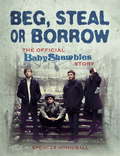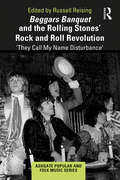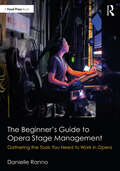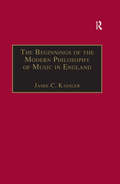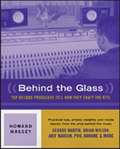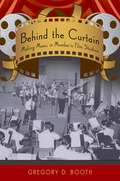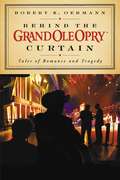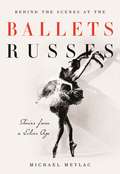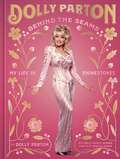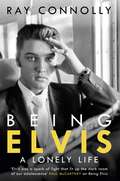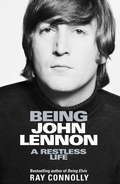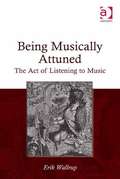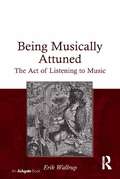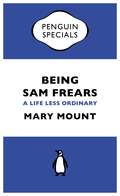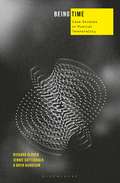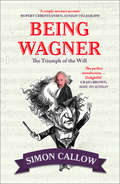- Table View
- List View
Beg, Steal or Borrow: The Official Baby Shambles Story
by Spencer HonniballCharting the wayward tale of the UK's most notorious group and written with full co-operation of the band this is the ultimate rock and roll story and is destined to become a classic of the genre. From rehab in a Thai monastery to riots at the Astoria, the tabloid exposé of Kate Moss to countless brushes with the law, the book is often funny, sometimes tragic, but always totally compelling. Currently riding high with a critically acclaimed album Sequel to the Prequel under their belt, a successful arena tour of Europe and the UK completed and a host of big festival dates lined up for the summer, Babyshambles are enjoying their most successful year to date.
Beggars Banquet and the Rolling Stones' Rock and Roll Revolution: ‘They Call My Name Disturbance' (Ashgate Popular and Folk Music Series)
by Russell ReisingThe Rolling Stones’ Beggars Banquet is one of the seminal albums in rock history. Arguably it not only marks the advent of the ‘mature’ sound of the Rolling Stones but lays out a new blueprint for an approach to blues-based rock music that would endure for several decades. From its title to the dark themes that pervade some of its songs, Beggars Banquet reflected and helped define a moment marked by violence, decay, and upheaval. It marked a move away from the artistic sonic flourishes of psychedelic rock towards an embrace of foundational streams of American music – blues, country – that had always underpinned the music of the Stones but assumed new primacy in their music after 1968. This move coincided with, and anticipated, the ‘roots’ moves that many leading popular music artists made as the 1960s turned toward a new decade; but unlike many of their peers whose music grew more ‘soft’ and subdued as they embraced traditional styles, the music and attitude of the Stones only grew harder and more menacing, and their status as representatives of the dark underside of the 60s rock counterculture assumed new solidity. For the Rolling Stones, the 1960s ended and the 1970s began with the release of this album in 1968.
Beggars Banquet and the Rolling Stones' Rock and Roll Revolution: ‘They Call My Name Disturbance' (Ashgate Popular and Folk Music Series)
by Russell ReisingThe Rolling Stones’ Beggars Banquet is one of the seminal albums in rock history. Arguably it not only marks the advent of the ‘mature’ sound of the Rolling Stones but lays out a new blueprint for an approach to blues-based rock music that would endure for several decades. From its title to the dark themes that pervade some of its songs, Beggars Banquet reflected and helped define a moment marked by violence, decay, and upheaval. It marked a move away from the artistic sonic flourishes of psychedelic rock towards an embrace of foundational streams of American music – blues, country – that had always underpinned the music of the Stones but assumed new primacy in their music after 1968. This move coincided with, and anticipated, the ‘roots’ moves that many leading popular music artists made as the 1960s turned toward a new decade; but unlike many of their peers whose music grew more ‘soft’ and subdued as they embraced traditional styles, the music and attitude of the Stones only grew harder and more menacing, and their status as representatives of the dark underside of the 60s rock counterculture assumed new solidity. For the Rolling Stones, the 1960s ended and the 1970s began with the release of this album in 1968.
The Beginner’s Guide to Opera Stage Management: Gathering the Tools You Need to Work in Opera
by Danielle RannoThe Beginner’s Guide to Opera Stage Management is the first book to cover theatrical stage management practices specifically for opera productions, providing an invaluable step-by-step guide. Beginning with a brief history of opera and detailing its difference from musical theatre, the book covers stage management best practices through prep, rehearsals, tech, performance, and wrap up. From the moment a manager accepts a contract, right through to archiving paperwork, this essential toolkit covers each step of a stage manager’s journey. Working with a score, reading music, working with singers, conductors, and musicians, basic duties of a stage manager versus an assistant stage manager, and other tasks specific to opera are also included in this comprehensive guide. This book is full of tips and tricks, as well as the good, bad, and ugly stories from opera stage managers, sharing both their experiences and mistakes. This is the perfect how-to book for the professional or emerging stage manager looking to work in opera, or to expand their existing stage management skillset.
The Beginner’s Guide to Opera Stage Management: Gathering the Tools You Need to Work in Opera
by Danielle RannoThe Beginner’s Guide to Opera Stage Management is the first book to cover theatrical stage management practices specifically for opera productions, providing an invaluable step-by-step guide. Beginning with a brief history of opera and detailing its difference from musical theatre, the book covers stage management best practices through prep, rehearsals, tech, performance, and wrap up. From the moment a manager accepts a contract, right through to archiving paperwork, this essential toolkit covers each step of a stage manager’s journey. Working with a score, reading music, working with singers, conductors, and musicians, basic duties of a stage manager versus an assistant stage manager, and other tasks specific to opera are also included in this comprehensive guide. This book is full of tips and tricks, as well as the good, bad, and ugly stories from opera stage managers, sharing both their experiences and mistakes. This is the perfect how-to book for the professional or emerging stage manager looking to work in opera, or to expand their existing stage management skillset.
The Beginnings of the Modern Philosophy of Music in England: Francis North's A Philosophical Essay of Musick (1677) with comments of Isaac Newton, Roger North and in the Philosophical Transactions
by Jamie C. KasslerIn 1677 a slim quarto volume was published anonymously as A Philosophical Essay of Musick. Written by Francis North (1637-85), chief justice of the Common Pleas, the Essay is in the form of a legal case argued from an hypothesis. Utilising the pendulum as his hypothesis, North provided a rationale from mechanics for the emerging new musical practice we now call 'tonality'. He also made auditory resonance the connecting link between acoustical events in the external world and the musical meanings the mind makes on the basis of sensory perception. Thus began the modern philosophy of music that culminated with the work of Hermann von Helmholtz. As a step towards understanding this tradition, Jamie C. Kassler examines the 1677 Essay in its historical context. After assessing three seventeenth-century criticisms of it and outlining how one critic developed some implications in the Essay, she summarises the basic principles that have guided the modern philosophy of music from its beginnings in the 1677 Essay. The book includes an annotated edition of the Essay as well as the comments of the three critics.
The Beginnings of the Modern Philosophy of Music in England: Francis North's A Philosophical Essay of Musick (1677) with comments of Isaac Newton, Roger North and in the Philosophical Transactions
by Jamie C. KasslerIn 1677 a slim quarto volume was published anonymously as A Philosophical Essay of Musick. Written by Francis North (1637-85), chief justice of the Common Pleas, the Essay is in the form of a legal case argued from an hypothesis. Utilising the pendulum as his hypothesis, North provided a rationale from mechanics for the emerging new musical practice we now call 'tonality'. He also made auditory resonance the connecting link between acoustical events in the external world and the musical meanings the mind makes on the basis of sensory perception. Thus began the modern philosophy of music that culminated with the work of Hermann von Helmholtz. As a step towards understanding this tradition, Jamie C. Kassler examines the 1677 Essay in its historical context. After assessing three seventeenth-century criticisms of it and outlining how one critic developed some implications in the Essay, she summarises the basic principles that have guided the modern philosophy of music from its beginnings in the 1677 Essay. The book includes an annotated edition of the Essay as well as the comments of the three critics.
Behind_Bars_Updated: The Definitive Guide To Music Notation (Faber Edition Ser.)
by Elaine GouldBehind Bars is the indispensable reference book for composers, arrangers, teachers and students of composition, editors, and music processors. In the most thorough and painstakingly researched book to be published since the 1980s, specialist music editor Elaine Gould provides a comprehensive grounding in notational principles. Behind Bars covers everything from basic rules, conventions and themes to complex instrumental techniques, empowering the reader to prepare music with total clarity and precision. With the advent of computer technology, it has never been more important for musicians to have ready access to principles of best practice in this dynamic field, and this book will support the endeavours of software users and devotees of hand-copying alike. The author's understanding of, and passion for, her subject has resulted in a book that is not only practical but also compellingly readable.
Behind The Glass: Top Record Producers Tell How They Craft The Hits VOL II (PDF)
by Howard MasseyÊBehind the Glass Volume IIÊ presents another prime collection of firsthand interviews with the world's top record producers and engineers sharing their creative secrets and hit-making techniques ä from the practical to the artistic. In these pages you'll find ±Daniel Lanois± (U2 Bob Dylan) discussing the future of digital recording; ±T-Bone Burnett± (Robert Plant and Alison Krauss) sharing his unique view of creating complex low end; and ±Hugh Padgham± (Police Genesis) analyzing the state of the business today. For real-world advice on everything from home recording to mixing to coaching a nervous singer check out author Howard Massey's conversations with ±Mark Ronson± (Amy Winehouse) ±Tony Brown± (Reba McEntire) ±Gus Dudgeon± (Elton John) ±John Simon± (The Band) ±Russ Titelman± (Steve Winwood) ±Bruce Swedien± (Michael Jackson) ±Rodney Jerkins± (Mary J. Blige) ±Simon Climie± (Eric Clapton) ±Matt Serletic± (Matchbox Twenty) and more.
Behind The Glass (PDF): Top Record Producers Tell How They Craft The Hits VOL I
by Howard MasseyIn this prime collection of first-hand interviews, 37 of the world's top record producers share their creative secrets and hit-making techniques - from the practical to the artistic. George Martin reveals the technical and musical challenges of working with The Beatles, while Phil Ramone, producer for such artists as Billy Joel, discusses studio wall treatments. Offering real-world advice on everything from mics to mixing to coaching a nervous singer, producers interviewed include Arif Mardin (Aretha Franklin), Brian Wilson (The Beach Boys), Alan Parsons (Pink Floyd) and more.
Behind the Curtain: Making Music in Mumbai's Film Studios
by Gregory D. BoothBeginning in the 1930s, men and a handful of women came from India's many communities-Marathi, Parsi, Goan, North Indian, and many others--to Mumbai to work in an industry that constituted in the words of some, "the original fusion music." They worked as composers, arrangers, assistants, and studio performers in one of the most distinctive popular music and popular film cultures on the planet. Today, the songs played by Mumbai's studio musicians are known throughout India and the Indian diaspora under the popular name "Bollywood," but the musicians themselves remain, in their own words, "behind the curtain"--the anonymous and unseen performers of one of the world's most celebrated popular music genres. Now, Gregory D. Booth offers a compelling account of the Bollywood film music industry from the perspective of the musicians who both experienced and shaped its history. In a rare insider's look at the process of musical production from the late 1940s to the mid 1990s, before the advent of digital recording technologies, Booth explains who these unknown musicians were and how they came to join the film music industry. On the basis of a fascinating set of first-hand accounts from the musicians themselves, he reveals how the day-to-day circumstances of technology and finance shaped both the songs and the careers of their creator and performers. Booth also unfolds the technological, cultural, and industrial developments that led to the enormous studio orchestras of the 1960s-90s as well as the factors which ultimately led to their demise in contemporary India. Featuring an extensive companion website with video interviews with the musicians themselves, Behind the Curtain is a powerful, ground-level view of this globally important music industry.
Behind the Grand Ole Opry Curtain: Tales of Romance and Tragedy
by Robert K. Oermann Grand Ole OpryThe Grand Ole Opry has been home to the greatest legends of country music for over eighty years, and in that time it has seen some of conutry music's most dramatic stories unfold. We'll hear of the great love stories ranging from Johnny Cash and June Carter in the 1960s to Garth Brooks and Trisha Yearwood, who married in 2005. We'll get the truth of the tragedies that led to the loss of three stars all in the same month, starting the rumor of the "Opry Curse." We'll learn how after being stabbed, shot, and maimed, Trace Adkins calls his early honky-tonk years "combat country," and we'll find inspiration from DeFord Bailey, an African American harmonica player in 1927 crippled by childhood polio who rose to fame as one of the first Opry stars. Our hearts will break for Willie Nelson, who lost his only son on Christmas Day, and soar for Amy Grant and Vince Gill, who found true love. Based on over 150 firsthand interviews with the stars of The Grand Ole Opry, these are stories that tell the heart of country--the lives that are lived and inspire the songs we love.
Behind the Scenes at the Ballets Russes: Stories from a Silver Age
by Michael MeylacThe Ballets Russes was perhaps the most iconic, yet at the same time mysterious, ballet company of the twentieth century. Inspired by the unique vision of their founder Sergei Diaghilev, the company gained a large international following. In the mid-twentieth century – during the tumultuous years of World War II and the Cold War – the Ballets Russes companies kept the spirit and traditions of Russian ballet alive in the West, touring extensively in America, Europe and Australia. This important new book uncovers previously-unseen interviews and provides insights into the lives of the great figures of the age – from the dancers Anna Pavlova and Alicia Markova to the choreographers Leonide Massine, George Balanchine and Anton Dolin. The dancers' own words reveal what life was really like for the stars of the Ballets Russes and provide fascinating new insights into one of the most vibrant and creative groups of artists of the modern age.
Behind the Seams: My Life in Rhinestones
by Dolly Parton'I hope that as you gaze upon my life in clothing, it will inspire you to develop, and celebrate, your own sense of style. I value my freedom to look like and be my own true self more than anything else, and I hope this book will also give you the confidence to look like and be the person you want to be. Whoever you are, be that! And enjoy your journey behind the seams' - DollyA beautifully illustrated celebration of Dolly Parton's iconic sense of style through entertaining personal stories and 450 full-color photographs, including exclusive images from her private costume archive.In Behind the Seams: My Life in Rhinestones, global superstar Dolly Parton shares, for the first time, the full story behind her lifelong passion for fashion, including how she developed her own, distinctly Dolly style, which has defied convention and endeared her to fans around the world.Featuring behind-the-scenes stories from Dolly Parton's life and career, and the largest reveal of her private costume archive, this gorgeously photographed book spotlights her most unforgettable looks from the 1960s to now. The sky-high heels, famous wigs, bold makeup, eye-catching stage clothes - she shares them all. Along the way, Parton discusses memorable outfits from her past, from the clothes her mother would sew out of feed sacks (including her "Coat of Many Colors") and the bold dresses and hairdos that shook up Nashville, to the bunny suit on the cover of Playboy, evening wear at Studio 54, costumes from her most famous film and TV roles, and the daring styles that continue to entertain and inspire today.Filled with candor, humor, and lots and lots of rhinestones, Behind the Seams: My Life in Rhinestones is a shining tribute to one of the most beloved musicians in history, a treasured keepsake for anyone who loves Dolly Parton, and an indispensable guide to forging your own path to beauty and confidence.
Being Elvis: The perfect companion to Baz Luhrmann’s major biopic
by Ray ConnollyThe perfect companion to Baz Luhrmann's forthcoming biopic Elvis, a major motion picture starring Tom Hanks and Austin Butler.What was it like to be Elvis Presley? What did it feel like when impossible fame made him its prisoner? As the world's first rock star there was no one to tell him what to expect, no one with whom he could share the burden of being himself - of being Elvis.On the outside he was all charm, sex appeal, outrageously confident on stage and stunningly gifted in the recording studio. To his fans he seemed to have it all. He was Elvis. With his voice and style influencing succeeding generations of musicians, he should have been free to sing any song he liked, to star in any film he was offered, and to tour in any country he chose. But he wasn't free. The circumstances of his poor beginnings in the American South, which, as he blended gospel music with black rhythm and blues and white country songs, helped him create rock and roll, had left him with a lifelong vulnerability. Made rich and famous beyond his wildest imaginings when he mortgaged his talent to the machinations of his manager, 'Colonel' Tom Parker, there would be an inevitable price to pay. Though he daydreamed of becoming a serious film actor, instead he grew to despise his own movies and many of the songs he had to sing in them. He could have rebelled. But he didn't. Why? In the Seventies, as the hits rolled in again, and millions of fans saw him in a second career as he sang his way across America, he talked of wanting to tour the world. But he never did. What was stopping him?BEING ELVIS takes a clear-eyed look at the most-loved entertainer ever, and finds an unusual boy with a dazzling talent who grew up to change popular culture; a man who sold a billion records and had more hits than any other singer, but who became trapped by his own frailties in the loneliness of fame.
Being John Lennon: A Restless Life
by Ray ConnollyJohn Lennon was a rock star, a school clown, a writer, a wit, an iconoclast, a sometime peace activist and finally an eccentric millionaire. He was also a Beatle - his plain-speaking and impudent rejection of authority catching, and eloquently articulating, the group's moment in history.Chronicling a troubled life, from that of the cast-aside child of a broken wartime marriage to his murder by a deranged fan, Being John Lennon analyses the contradictions in the singer-songwriter's creative and destructive personality. A leader who could be easily led, he was often generous and often funny, but sometimes scathingly cruel.As a journalist, author Ray Connolly had a close working relationship with Lennon, and the entire Beatles coterie. In this biography he unsparingly reassesses the chameleon nature of the perpetually dissatisfied star who just couldn't stop reinventing himself. Drawing on many interviews and conversations with Lennon, his first wife Cynthia and second Yoko Ono, as well as his girlfriend May Pang and song-writing partner Paul McCartney, this complex portrait is a revealing insight into a restless man whose emotional turbulence governed his life and talent.
Being Musically Attuned: The Act Of Listening To Music (PDF)
by Erik WallrupListening according to mood is likely to be what most people do when they listen to music. We want to take part in, or even be part of, the emerging world of the musical work. Using the sources of musical history and philosophy, Erik Wallrup explores this extremely vague and elusive phenomenon, which is held to be fundamental to musical hearing. Wallrup unfolds the untold musical history of the German word for 'mood', Stimmung, which in the 19th century was abundant in the musical aesthetics of the German-Austrian sphere. Martin Heidegger's much-discussed philosophy of Stimmung is introduced into the field of music, allowing Wallrup to realise fully the potential of the concept. Mood in music, or, to be more precise, musical attunement, should not be seen as a peculiar kind of emotionality, but that which constitutes fundamentally the relationship between listener and music. Exploring mood, or attunement, is indispensable for a thorough understanding of the act of listening to music.
Being Musically Attuned: The Act Of Listening To Music
by Erik WallrupListening according to mood is likely to be what most people do when they listen to music. We want to take part in, or even be part of, the emerging world of the musical work. Using the sources of musical history and philosophy, Erik Wallrup explores this extremely vague and elusive phenomenon, which is held to be fundamental to musical hearing. Wallrup unfolds the untold musical history of the German word for 'mood', Stimmung, which in the 19th century was abundant in the musical aesthetics of the German-Austrian sphere. Martin Heidegger's much-discussed philosophy of Stimmung is introduced into the field of music, allowing Wallrup to realise fully the potential of the concept. Mood in music, or, to be more precise, musical attunement, should not be seen as a peculiar kind of emotionality, but that which constitutes fundamentally the relationship between listener and music. Exploring mood, or attunement, is indispensable for a thorough understanding of the act of listening to music.
Being Musically Attuned: The Act of Listening to Music
by Erik WallrupListening according to mood is likely to be what most people do when they listen to music. We want to take part in, or even be part of, the emerging world of the musical work. Using the sources of musical history and philosophy, Erik Wallrup explores this extremely vague and elusive phenomenon, which is held to be fundamental to musical hearing. Wallrup unfolds the untold musical history of the German word for ’mood’, Stimmung, which in the 19th century was abundant in the musical aesthetics of the German-Austrian sphere. Martin Heidegger’s much-discussed philosophy of Stimmung is introduced into the field of music, allowing Wallrup to realise fully the potential of the concept. Mood in music, or, to be more precise, musical attunement, should not be seen as a peculiar kind of emotionality, but that which constitutes fundamentally the relationship between listener and music. Exploring mood, or attunement, is indispensable for a thorough understanding of the act of listening to music.
Being Musically Attuned: The Act of Listening to Music
by Erik WallrupListening according to mood is likely to be what most people do when they listen to music. We want to take part in, or even be part of, the emerging world of the musical work. Using the sources of musical history and philosophy, Erik Wallrup explores this extremely vague and elusive phenomenon, which is held to be fundamental to musical hearing. Wallrup unfolds the untold musical history of the German word for ’mood’, Stimmung, which in the 19th century was abundant in the musical aesthetics of the German-Austrian sphere. Martin Heidegger’s much-discussed philosophy of Stimmung is introduced into the field of music, allowing Wallrup to realise fully the potential of the concept. Mood in music, or, to be more precise, musical attunement, should not be seen as a peculiar kind of emotionality, but that which constitutes fundamentally the relationship between listener and music. Exploring mood, or attunement, is indispensable for a thorough understanding of the act of listening to music.
Being Sam Frears: A Life Less Ordinary (Penguin Specials)
by Mary MountThis is Sam Frears' story.This is also the story of an actor, a rock-climber and a man born with an extremely rare genetic disorder only affecting Ashkenazi Jews. Sam was supposed to live to the age of 5. In February, he celebrated his 40th birthday.Challenged by blindness and a body under great stress, Sam Frears is trying to live an ordinary life under extraordinary circumstances His struggles and triumphs offer an illuminating look at the differences - and similarities - that make us human. For those who enjoyed My Left Foot and Stuart: A Life Backwards, this Penguin Special offers a fresh look at what it's like to be Sam.
Being Time: Case Studies in Musical Temporality
by Jennie Gottschalk Richard Glover Bryn HarrisonBeing Time invites a deep consideration of the personal experience of temporality in music, focusing on the perceptual role of the listener. Through individual case studies, this book centers on musical works that deal with time in radical ways. These include pieces by Morton Feldman, James Saunders, Chiyoko Szlavnics, Ryoji Ikeda, Toshiya Tsunoda, Laurie Spiegel and André O. Möller. Multiple perspectives are explored through a series of encounters, initially between an individual and a work, and subsequently with each author's varying experiences of temporality. The authors compare their responses to features such as repetition, speed, duration and scale from a perceptual standpoint, drawing in reflections on aspects such as musical memory and anticipation. The observations made in this book are accessible and relevant to readers who are interested in exploring issues of temporality from a broad range of disciplinary perspectives.
Being Time: Case Studies in Musical Temporality
by Jennie Gottschalk Richard Glover Bryn HarrisonBeing Time invites a deep consideration of the personal experience of temporality in music, focusing on the perceptual role of the listener. Through individual case studies, this book centers on musical works that deal with time in radical ways. These include pieces by Morton Feldman, James Saunders, Chiyoko Szlavnics, Ryoji Ikeda, Toshiya Tsunoda, Laurie Spiegel and André O. Möller. Multiple perspectives are explored through a series of encounters, initially between an individual and a work, and subsequently with each author's varying experiences of temporality. The authors compare their responses to features such as repetition, speed, duration and scale from a perceptual standpoint, drawing in reflections on aspects such as musical memory and anticipation. The observations made in this book are accessible and relevant to readers who are interested in exploring issues of temporality from a broad range of disciplinary perspectives.
Beiträge zur Jahrestagung der Gesellschaft für Musikforschung in Kassel 2017: Das Populäre in der Musik und das Musikverlagswesen (Systematische Musikwissenschaft)
by Annette van Dyck-Hemming Jan HemmingDieses Buch versammelt Ansätze der Musikwissenschaft, die auf der Tagung der Gesellschaft für Musikforschung in Kassel 2017 diskutiert wurden. Studien zu Gitarrenriffs im Heavy Metal, Vokalmusik der Renaissance oder Techno stehen dabei neben Untersuchungen zum Einfluss Th. W. Adornos auf die Forschung und Forderungen, populäre Musik ernst zu nehmen. Zweiter Themenschwerpunkt sind Verlage, ihre Netzwerke und ihr Verhältnis u. a. zu Beethoven sowie Fragen zu Urheberrecht und digitaler Publikation. Der Band dokumentiert die Vielfalt musikologischer Forschung, die sich mit Musikwirtschaft und -software, Aufnahmetechnik, aber auch Instrumentenbau, Klaviersonaten und der Freundschaft zwischen Luciano Berio und Umberto Eco beschäftigt, und gibt so Antworten auf aktuelle und historische musikalische Fragen.
